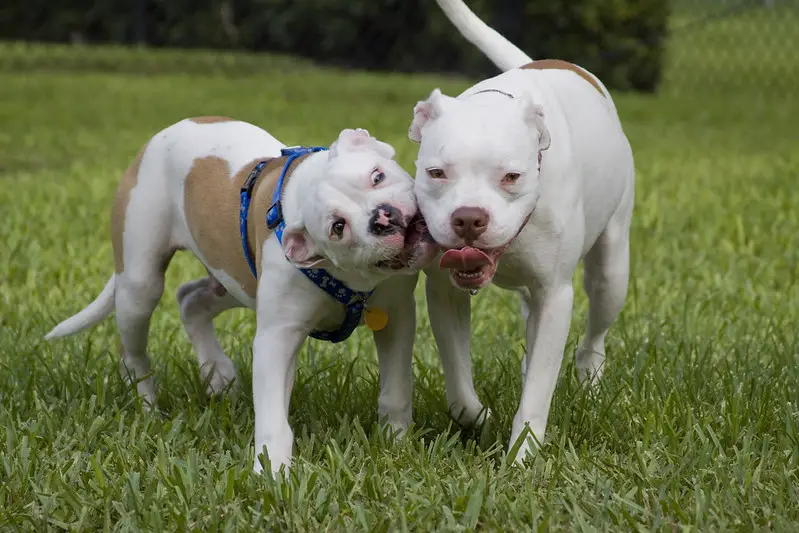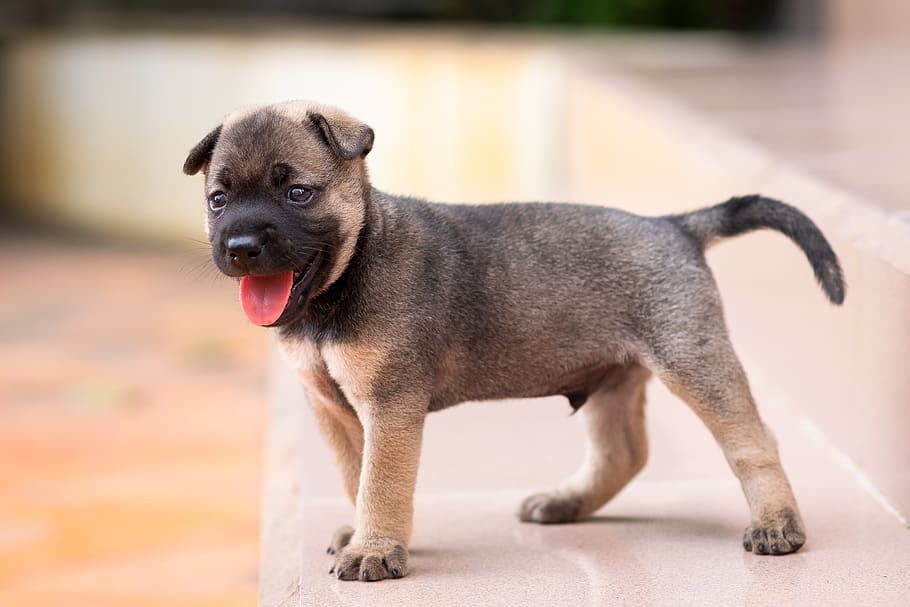Have you been pondering over why a dog does what it does? Perhaps you’ve recently wanted to know why do dogs put their tails down?
In this guide, I will answer this question and also cover:
- 11 Reasons why do dogs put their tails down
- 4 Tips to prevent dogs from putting the tail down
- And more…
Why Do Dogs Put Their Tails Down?
Dogs put their tails down when stressed, nervous, submissive, fearful, unsure, or anxious. They also bring their tails down when sick or injured. Some dogs keep their tails down due to shyness or timidity. In some dog breeds, limber tail or swimmer’s tail can also cause the tail to be limp at all times.
Let us dive deeper into this…
11 Reasons Why Do Dogs Put Their Tails Down?

Here are common reasons why a dog might put its tail down:
1. Nervousness/anxiety
A dog with its tail down is trying to convey anxiety, stress, or nervousness.
AKC’s canine expert Stephanie Gibeault, MSc, CPDT believes that dogs convey important information through their body language and especially with their tails.
Gibeault further states that owners should learn to observe their dog’s tail positions to decipher their pet’s emotional states. This knowledge can be very useful during training and also help prevent bites, aggression, and other unwanted behaviors.
In addition to putting its tail down, a nervous or anxious dog might also show the following signs:
- Yawning
- Drooling
- Panting
- Pacing
- Appearing restless
- Destructive behavior like digging, destroying furniture, etc.
If your dog’s separation anxiety or nervousness is causing issues, please seek help from a certified canine behaviorist.
Also Read: Do Chihuahuas Have Separation Anxiety? The Answer May Surprise You!
2. Meekness or submission to you/other dog

When a dog makes its body small, tucks the tail in between its legs, hides, or licks another dog’s chin, it is a sign of meekness or submission.
Submission is instinctual in dogs. Even wolves show this behavior. Dogs might even submit to their humans to show that they accept them as their alpha. This is a sign of respect as the dog is looking up to you for protection.
A submissive dog is always calm and never aggressive. In dog hierarchy, a submissive dog may be afraid of another dog. As a dog owner, you’d want your dog to show at least a bit of dominance and you can help you submissive dog with the following tips:
- Socialize your dog by getting it to interact with many dogs. Do this slowly – do not force it.
- In your home, give the submissive dog a safe place to rest.
- Positively praise and reward your dog when it asserts itself.
Also Read: 18 Surprising Reasons Why Your Dog May Be Chewing Its Tail?
3. Fear or phobia
When the tail is tucked under the abdomen, the dog is very frightened.
During 4th of July or New Year Eve’s Fireworks, there are hundreds of incidents reported of pets going missing. Dogs afraid of such loud noises tend to walk with their tails down or even hide under the furniture.
According to the AKC, common phobias in dogs include:
- Fear of thunderstorms, fireworks, and other loud noises like construction, vehicles backfiring, etc.
- Fear of being left alone
- Blood injection phobias/fear of vets
- Fear of strangers
Some of these phobias are also genetic or breed specific. For example, herding dogs are more susceptible to loud sound/noise phobia since they are so attuned to their environment.
Signs of fear and phobias in dogs include:
- Pacing restlessly with the tail down
- Panting, inability to settle down
- Refusing food
- Shaking or trembling
- Hiding
AKC’s Chief Veterinary Officer Dr. Jerry Klein believes that phobias in dogs can be treated with desensitization and medication. He also advises pet parents to seek help from certified canine behaviorists since it is important to control the phobia from the beginning. Failure to do so can cause the behaviors to spiral out of control.
4. When they feel they are in trouble/Guilt
When a dog has a tucked tail, shows visible whites of the eyes, assumes a cowering position, and has flattened ears, then the dog feels it is in trouble.
Dogs are very much capable of human emotions like guilt. Dr. Mary R. Burch, certified animal behaviorist, has studied guilt in dogs. She says that dogs that indulge in house soiling, chewing furniture, etc. might have experienced cold shoulder treatment, yelling or even punishments from their owners.
Such dogs then show this guilt through their body language and one of the signs is a tucked tail. This might seem funny and cute to dog owners.
However, Dr. Burch cautions pet parents against poking fun at a dog that may be feeling guilty since dogs are sensitive animals and human reactions like punishments or poking fun could all backfire.
This means that your dog might start urinating in the basement or behind/under the furniture. It is better to correct the behavior rather than punishing your dog. You can consider options like hiring a dog-walker, crate training your dog or seek help of a canine behaviorist to overcome the issue.
5. Timidity or shyness
A dog with a tucked tail, ears flattened back, cowering posture, dilated glassy eyes, and shying away from interactions with humans or other dogs is showing timidity.
Dr.Jason Sweitzer – a vet at Conejo Valley California, states that timidity or aloofness is not that uncommon in dogs. Sure, dogs are pack animals but ever since humans have started domesticating them, many dogs prefer being alone and do not readily socialize with other dogs.
Often, the timidity can also be a result of fear. Dr. Liz Stelow, chief of service of Clinical Animal Behavior Service at the Veterinary Medical Teaching Hospital at University of California, Davis agrees.
She states that aloof or timid dogs also show aggression and other signs like:
- Hiding
- Barking
- Growling
- Snapping/snarling
- Biting.
Many dog breeds are prone to being aloof. These include Huskies, malamutes, Samoyeds, and livestock guarding breeds like Anatolian Shepherds, Pyrenees, etc.
The good news is that if your dog is otherwise healthy and happy, you need not force it to socialize with other dogs or humans.
6. Over-exertion/ Physical malaise
Dogs often put their tails down when they are over-exerted, tired, or generally feeling inactive. They may sleep or hide if they are very tired. A tired dog will refuse to go on walks and might not even eat.
Over-exertion is typically seen in dogs that are not exercised adequately on a regular basis and then suddenly exposed to strenuous activity.
Such a dog might also put its tail down because it has a muscle injury or swelling at the base of the tail, or sprain.
According to the experts at Oakland Veterinary Services, signs of over-exercised dogs are:
- Mobility issues
- Avoidance behavior – refusal/reluctance to go on walks and eat.
- Anxiety
- Lethargy
Sometimes, simple home remedies like applying a warm compress to the tail followed by adequate rest will get your dog’s tail wagging happily again.
If the issue isn’t resolved soon, then please see your vet.
Also Read: How Much Exercise Does a Chihuahua Need? (You’d Be Surprised to Know!)
7. Medical issues
A sick dog will show many different signs like tucked tail in between the legs and under the abdomen, vomiting, swelling, bleeding, diarrhea, etc. depending on the cause.
Medical conditions like prostate trouble, osteoarthritis, and anal gland abscesses can also cause a dog to put its tail down due to the pain.
The low-tail position might help your dog alleviate its discomfort to a small degree. This is usually seen in long-tailed dog breeds although all dogs tend to hold their tails down when they are sick.
It is best to get your dog examined by your vet especially if your dog shows other signs like pain, appetite and behavior changes, etc. in addition to putting down its tail.
8. Injury/Limber tail/Cold tail syndrome
Dogs with limber tail often show complete or partial limp tail, absence of wagging, whining, discomfort or pain, licking or chewing the tail, lethargy, refusal to go on walks.
Pet expert Erin Askeland, CBCC-KA, CPDT-KA of Camp Bow Wow says that a dog’s tail isn’t just a cute appendage; it is an extension of its back bone.
Therefore, an injury to the vertebrae or spinal column can cause a tail to go limp. If your pet isn’t able to wag its tail and it remains limp at all times, then please have your vet rule out nerve damage, dislocation, trauma, tailbone fracture,intervertebral disc disease, cancer of the tail, or injury.
Some dog breeds are prone to limber tail (also known as swimmer’s tail, broken wag, frozen tail, cold-water tail, or cold tail.) It can occur due to prolonged confinement, swimming in cold water, over exercise, etc. According to the AAHA breeds like Retrievers, Pointers, Beagles, Setters, and Hounds and breeds that hunt or swim often show limber tail syndrome..
Never neglect a limp tail in dogs because it could give rise to incontinence, lack of balance and coordination, not to mention that it is an important means of communicating different aspects about your dog’s health.
Prevention of limber tail is possible by:
- slowly building your dog’s stamina,
- keeping it warm in cold weather,
- avoiding prolonged confinement during hunting, swimming competitions.
- Also, dry your dog thoroughly if it is wet due to the rain, snow, and especially after swimming.
9. Depression
A dog with depression might put its tail down, avoid going on walks, sleep all day, and lick or chew its paws and tails.
According to PetMD, dogs can get depressed if a fellow dog or a favorite human dies or when a stay-at-home owner takes up a full time job.
To treat depression in dogs, vets recommend taking the dog out for car rides and rewarding even the slightest wagging of the tail.
Most dogs can be brought out of depression with plenty of love and positive reinforcement – treating the dog when it seems even slightly happier.
It is important not to reinforce the negative behavior (which pet parents might accidentally) do by rewarding the dog when it is moping or appearing sad.
10. Exposure to cold weather
Dogs that are cold tend to hunch their backs, tuck their tails, and shiver and shake. They also lift their paws off the ground, hide under beds, and seek warmth.
The experts at the Ontario SPCA Humane Society urge pet parents to not take these signs of cold exposure in dogs lightly as it could even result in hypothermia.
They also recommend cutting down the dog’s walks shorter, especially when the temperature is freezing. You can include some indoor activities to keep your dog mentally and physically fit. If your pet is still uncomfortable, dress it up in warm clothes and adjust the indoor heating. Feed it some hearty warming stew or soup.
11. Prolonged confinement
Signs a dog has been confined too long in a small space include tail down, inability to walk, limping, legs shaking while walking, signs of pain or discomfort, falling down while walking and/or stopping, turning back on walks, etc.
Crate training can help you take advantage of a dog’s natural instinct to sleep in cozy, covered spaces. However, crating for prolonged periods could cause above symptoms in addition to tucked in tail or limp tail. It is similar to a human being’s foot ‘falling asleep’ after sitting in one position for a long time.
Dogs also need daily exercise and mental stimulation – therefore, crating or confining for hours at a stretch is not at all the best solution – especially if you are doing it to resolve behavioral issues.
According to the Humane Society, here are some rules to follow if you crate your pet:
- Choose a crate of the right size – not too big or too small. Section off a bigger crate using boxes or partitions.
- Crate your puppy (under 6 months) for just 1-2 hours at a time (making sure to provide potty breaks before and after crating).
- Add plenty of interactive toys in the crate.
- Crate your adult dog for slightly longer but always make sure it has been fed, exercised, and has access to fresh drinking water.
- Arrange for a dog-walker to come and walk your dog while you are at work.
4 Tips to Prevent Down Tail in Dogs

You can help prevent pet’s limp tail by using the following tips:
1. Avoid overexertion
Always build stamina before exposing your dog to long sessions of hunting, running, or swimming.
2. Keep it warm
You can use a warm compress or give it electric heating pads to rest on. The heat will soothe its muscles and eliminate pain.
3. Provide a crate of proper size
If you confine your dog, avoid prolonged confinement. Always select a crate of the proper size. Hire a dog walker to relieve your dog from time to time. This will give your dog a chance to stretch its limbs and tail.
4. Desensitize it
If fear or anxiety is the cause of limp tail, then desensitize your dog to the object of its fear. For example, CDs with sounds of fireworks, thunderstorms etc. can help. Socializing your submissive dog to other dogs can also eliminate fear and submissive behavior.
Always pay attention to your dog’s tail and also be aware of its breed and normal position. Some dog breeds are prone to tail injuries. If anything seems out of the ordinary, consult your vet right away.



